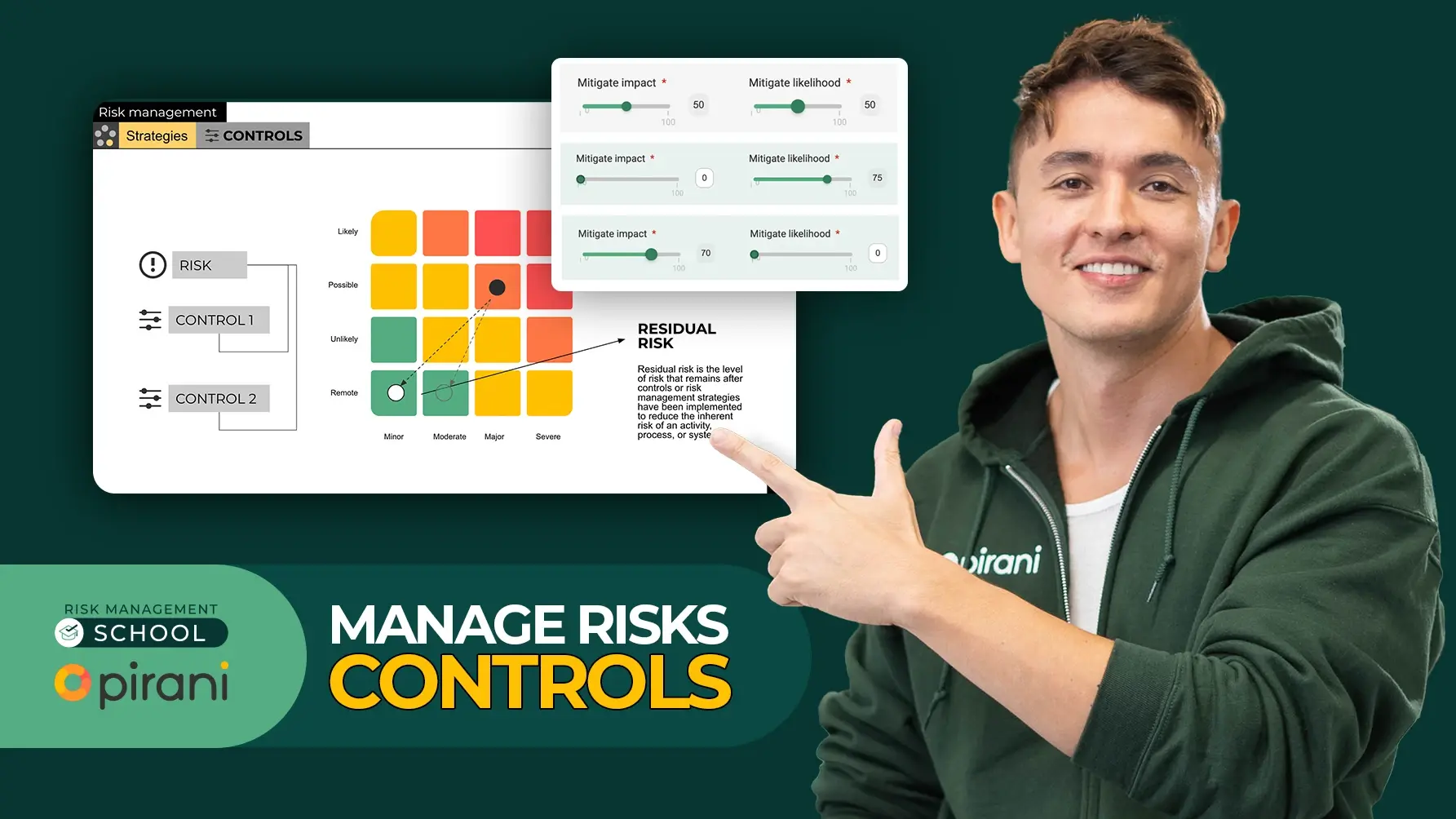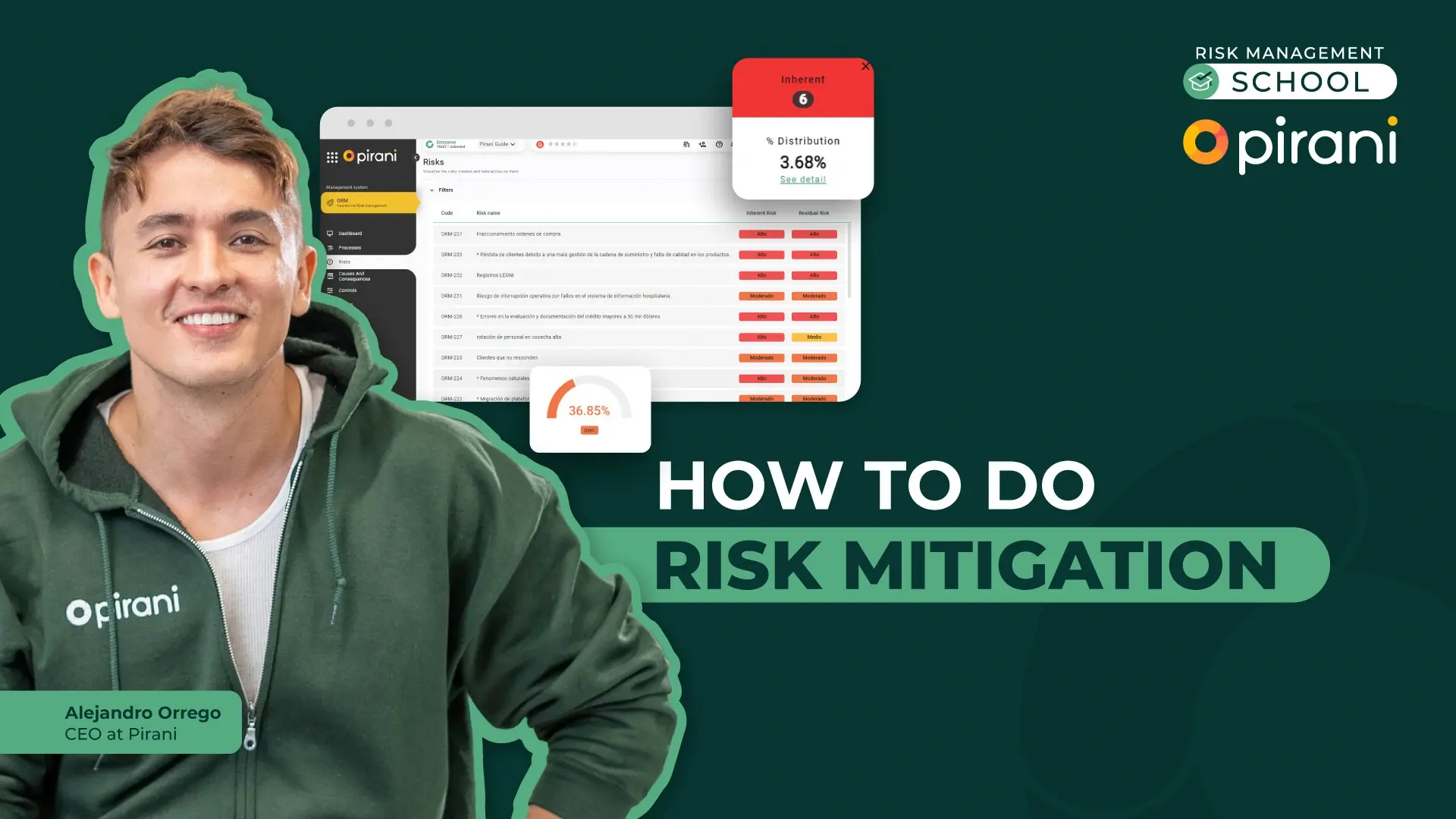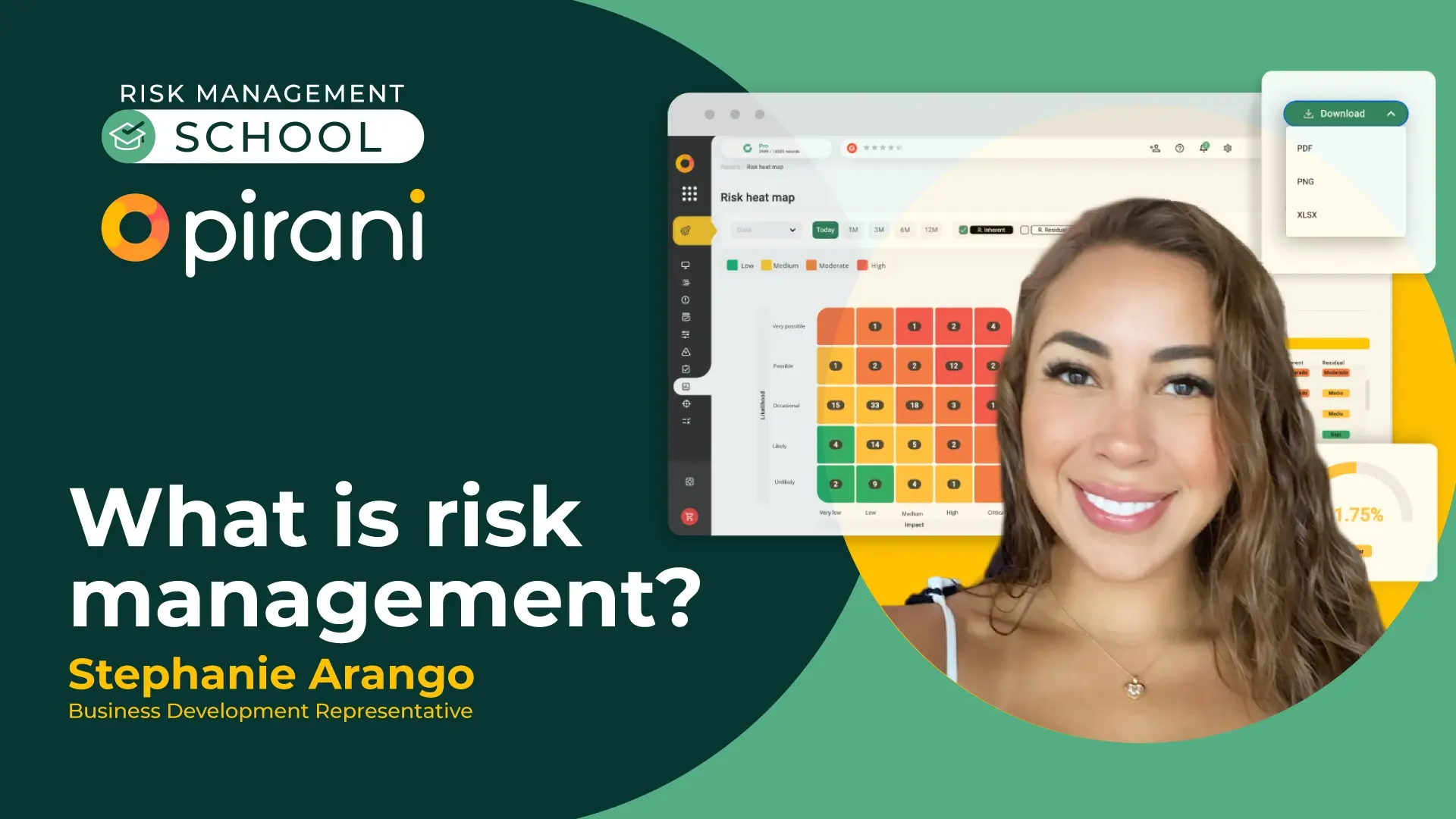Overview of Risk Management Frameworks and Their Benefits
by Risk Management School on 28 de June de 2024
In this class, Alejandro Orrego, CEO at Pirani, teaches us about RMFs, their key components, their benefits, the 9 most important RMFs, and the differences between frameworks, certifications, and policies.
RISK MANAGEMENT FRAMEWORKS
A risk management framework is a structured approach that organizations use to identify, assess, manage, and monitor risks.
It provides a systematic process to deal with potential events or conditions that could affect the achievement of an organization’s objectives.
A robust risk management framework helps ensure that risks are properly managed and mitigated, and opportunities are identified and maximized.
KEY COMPONENTS of a Risk Management Framework
- Governance and Leadership
- Risk Management Process
- Risk Culture
- Integration with Organizational Processes
1. Governance and Leadership:
- Leadership and Commitment: Senior management must commit to and support the risk management framework.
- Risk Management Policy: A formal statement of the organization’s approach to risk management.
- Roles and Responsibilities: Clearly defined roles for those involved in risk management.
2. Risk Management Process:
- Communication and Consultation: Engaging stakeholders to understand and consider their perspectives on risk.
- Establishing the Context:
- Internal Context: Organizational structure, culture, and internal stakeholders.
- External Context: Economic, regulatory, and competitive environment.
- Risk Criteria: Defining criteria for evaluating risk significance.
- Risk Assessment:
- Risk Identification: Identifying risks that could impact the organization.
- Risk Analysis: Understanding the nature, sources, and impacts of identified risks.
- Risk Evaluation: Comparing the level of risk against risk criteria to determine its significance.
- Risk Treatment:
- Identifying and implementing measures to mitigate, transfer, accept, or avoid risks.
- Developing and implementing action plans.
- Monitoring and Review: Continuously monitoring risks and the effectiveness of risk treatment measures. Adjusting strategies and actions as needed.
- Recording and Reporting: Documenting the risk management process and communicating outcomes to stakeholders.
3. Risk Culture:
- Awareness and Training: Educating employees about risk management principles and practices.
- Behavior and Attitude: Encouraging a proactive approach to identifying and managing risks.
4. Integration with Organizational Processes
- Strategic Planning: Aligning risk management with the organization’s strategic goals.
- Decision Making: Ensuring risk considerations are part of decision-making processes.
- Operational Processes: Embedding risk management into day-to-day operations.
BENEFITS of a Risk Management Framework
- Enhanced Decision Making: Provides a basis for making informed decisions about risks and opportunities.
- Improved Performance: Helps achieve objectives by addressing risks proactively.
- Regulatory Compliance: Ensures compliance with legal and regulatory requirements.
- Resource Optimization: Allocates resources efficiently by prioritizing risk treatments.
- Resilience and Sustainability: Enhances the organization’s ability to respond to and recover from adverse events.
9 MOST IMPORTANT RISK MANAGEMENT FRAMEWORKS
- ISO 31000
- COSO ERM
- NIST RMF
- ITIL
- COBIT
- OCTAVE
- FAIR
- PMBOK
- PRINCE2
1. ISO 31000 (International Organization for Standardization)
- Overview: ISO 31000 provides guidelines on managing risk faced by organizations. It is not industry-specific and can be applied to any organization.
- Principles:
- Integrated
- Structured and comprehensive
- Customized
- Inclusive
- Dynamic
- Best available information
- Human and cultural factors
- Continual improvement
- Last version: 2018 - ISO 31050: 2023
2. COSO ERM (Committee of Sponsoring Organizations Enterprise Risk Management Framework)
- Overview: COSO ERM provides a comprehensive approach to risk management, integrating it with strategy and performance.
- Components:
- Governance and Culture
- Strategy and Objective-Setting
- Performance
- Review and Revision
- Information, Communication, and Reporting
- Last version: 2017
3. NIST Risk Management Framework (National Institute of Standards and Technology)
- Overview: NIST RMF provides a structured process for integrating security and risk management activities into the system development life cycle.
- Steps:
- Prepare
- Categorize
- Select
- Implement
- Assess
- Authorize
- Monitor
- Last version: SP 800-53 Controls and SP 800-53B Control Baselines
Resources for Implementers, Updated June 14, 2024.
NIST SP Special Publication.
These publications are documents that provide guidelines, recommendations, and best practices for various aspects of information security, cybersecurity, and privacy. NIST SPs are widely used by federal agencies, businesses, and other organizations to enhance their security posture and ensure compliance with regulatory requirements.
- NIST SP 800-53: Security and Privacy Controls for Information Systems and Organizations
- NIST SP 800-37: Risk Management Framework (RMF) for Information Systems and Organizations
- NIST SP 800-171: Protecting Controlled Unclassified Information (CUI) in Non-Federal Systems and Organizations
- NIST SP 800-53A: Assessing Security and Privacy Controls in Information Systems and Organizations
- NIST SP 800-30: Guide for Conducting Risk Assessments
- NIST SP 800-61: Computer Security Incident Handling Guide
- NIST SP 800-63: Digital Identity Guidelines
- NIST SP 800-82: Guide to Industrial Control Systems (ICS) Security
- NIST SP 800-34: Contingency Planning Guide for Federal Information Systems.
4. ITIL (Information Technology Infrastructure Library)
- Overview: The Information Technology Infrastructure Library (ITIL) is a set of practices and a framework for IT activities such as IT service management (ITSM) and IT asset management (ITAM) that focus on aligning IT services with the needs of the business. Certification in ITIL is only available to individuals and not organizations. Since 2021, the ITIL trademark has been owned by PeopleCert.
- Risk Management Aspects:
- Risk identification
- Risk analysis
- Risk evaluation
- Risk treatment
- Risk monitoring and review
- Communication and consultation
- Last version: ITIL v4 - 2019
5. COBIT (Control Objectives for Information and Related Technologies)
- Overview: COBIT is a framework created by ISACA for information technology (IT) management and IT governance.
- The framework is business focused and defines a set of generic processes for the management of IT, with each process defined together with process inputs and outputs, key process-activities, process objectives, performance measures and an elementary maturity model.
- Risk Management Domains:
- Align, Plan and Organize
- Build, Acquire and Implement
- Deliver, Service and Support
- Monitor, Evaluate and Assess
- Last version: 2019
6. OCTAVE (Operationally Critical Threat, Asset, and Vulnerability Evaluation)
- Overview: OCTAVE is a risk-based strategic assessment and planning technique for cybersecurity.
- Phases:
- Build asset-based threat profiles
- Identify infrastructure vulnerabilities
- Develop security strategy and plans
- Last version: 2005
7. FAIR (Factor Analysis of Information Risk)
- Overview: FAIR is a model for understanding, analyzing, and quantifying information risk in financial terms.
- Components:
- Risk
- Loss Event Frequency
- Vulnerability
- Threat Event Frequency
- Contact Frequency
- Probability of Action
- Loss Magnitude
8. PMBOK (Project Management Body of Knowledge)
- Overview: PMBOK is a set of standard terminology and guidelines (a body of knowledge) for project management.
This document results from work overseen by the Project Management Institute (PMI). - Risk Management Processes:
- Plan Risk Management
- Identify Risks
- Perform Qualitative Risk Analysis
- Perform Quantitative Risk Analysis
- Plan Risk Responses
- Implement Risk Responses
- Monitor Risks
- Last version: 2021 PMBOK Guide, Seventh Edition
9. PRINCE2 (Projects IN Controlled Environments)
- Overview: PRINCE2 is a project management methodology that emphasizes dividing projects into manageable and controllable stages.
- PRINCE2 is a process-based method for effective project management, and this qualification will equip you with the fundamental skills needed to be a successful project manager.
- Risk Management Approach:
- Identify
- Assess
- Plan
- Implement
- Communicate
- Last version: 2023 PRINCE2 7th Edition.
Differences Between Frameworks, Certifications, and Policies
- Frameworks: Provide structured approaches and methodologies for managing risks, processes, or systems (e.g., COSO ERM, ISO 31000).
- Certifications: Formal recognition by an authoritative body that an organization or individual meets certain standards (e.g., ISO/IEC 27001, PCI DSS (Payment Card Industry Data Security Standard)).
- Policies/Regulations: Rules or laws that mandate specific requirements and behaviors (e.g., GDPR, HIPAA).
- NIST Cybersecurity Framework (NIST CSF)
- Guideline/Standard: The NIST CSF is a set of industry standards and best practices to help organizations manage cybersecurity risks.
- Framework: Clearly a framework, but sometimes referred to as a guideline or standard due to its prescriptive nature.
- COBIT (Control Objectives for Information and Related Technologies)
- Framework: COBIT is a framework for developing, implementing, monitoring, and improving IT governance and management practices.
- Certification: There are COBIT certifications for professionals, which can lead to confusion between the certification and the framework itself.
- ITIL (Information Technology Infrastructure Library)
- Framework: ITIL is a framework for IT service management that focuses on aligning IT services with business needs.
- Certification: There are ITIL certifications for professionals, which might lead to confusion between the certification and the framework.
- SOC 2 (System and Organization Controls 2)
Certification is not a framework in the traditional sense; rather, it is a set of criteria and guidelines for managing customer data based on five "trust service principles." These principles are defined by the American Institute of Certified Public Accountants (AICPA) and are used to assess the controls relevant to security, availability, processing integrity, confidentiality, and privacy.
- Monte Carlo Method
The Monte Carlo method is not a framework; it is a statistical technique used for modeling and simulating various processes to understand the impact of risk and uncertainty in prediction and forecasting models. It is widely used in fields such as finance, engineering, project management, and many scientific disciplines.
You May Also Like
These Related Stories

[class #3] How to create effective risk management controls

Effective strategies for risk mitigation



No Comments Yet
Let us know what you think